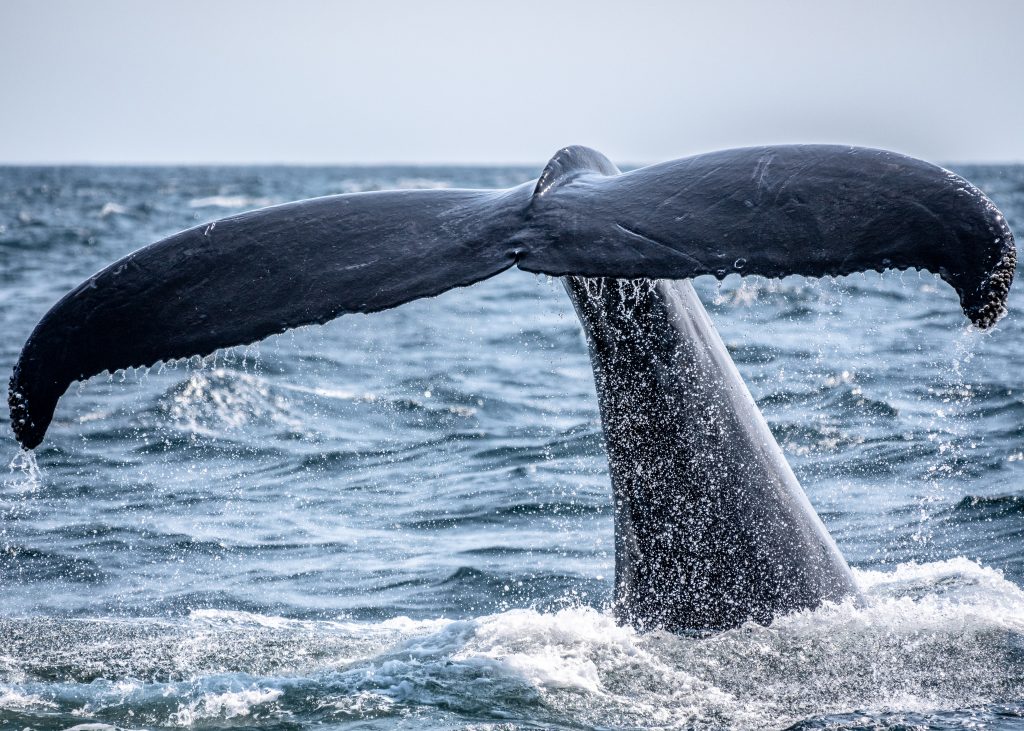What can you tell from the poop whales leave behind as they swim through the sea? Quite a lot, according to Associate Professor Leigh Torres.
“Understanding whale physiology is really important to evaluate how human, activities impact whales, but it is really, really hard to study whale physiology,” Torres says. “You can’t observe most physiological responses. And you can’t just ask a whale, ‘Are you stressed out?’ So we have to get creative.”
Ethically, biologists prefer to study animals without harming them, including by causing them stress and anxiety. This is especially so, obviously, when their stress levels are the thing under consideration. Using a harpoon to take tissue biopsies, for instance, would be neither ethical nor effective in the case of a whale.
Torres is part of Oregon State University’s Marine Mammal Institute and director of their Geospatial Ecology of Marine Megafauna Laboratory. Between 2016 and 2018, these groups collected 158 cetacean poops from gray whales off the Oregon Coast – more was collected in 2019 and 2020, and will be studied later. Analyzing them, GEMM researchers created a baseline of normal hormone levels in Eastern North Pacific grays. They believe this is the first time anyone has used whale droppings in this fashion. They hoped that collecting cachalot feces would be effective while remaining non-invasive.
A new study from OSU concludes that it is.
Leila Soledade Lemos, a newly-minted PhD from OSU’s Department of Fisheries and Wildlife, has just published that study in the journal Conservation Physiology while doing postdoctoral work at Florida International University. She shared authorship with Todd Chandler of Oregon State, Kathleen Hunt of the Smithsonian-Mason School of Conservation, and the Seattle Aquarium team of Amy Olsen, Angela Smith and Shawn Larson.
Gray Whale Feeding Grounds
Gray whales typically feed most heavily in the cold waters of the far north, near Alaska and Siberia, where the cold water contains more dissolved oxygen and thus life is more abundant. The whales whose leavings were collected for the GEMM study, though, are known as the Pacific Coast Feeding Group, because they collect their food between British Columbia and Baja California. This makes them convenient for the OSU team to study, since they pass frequently along the Oregon Coast.
The movement and behavior of the Pacific Coast Feeding Group are observed and photographed by GEMM researchers from boats and drones. When a whale is seen defecating, a boat pulls into the whale’s wake and the load is scooped from the water in nets.
The whale stool is analyzed for the digestive breakdown products of two reproductive hormones, a stress hormone and thyroid. Thyroid is especially useful in measuring stress relating to nutrition. As data collects over a span of years, hormone levels can be tracked for each whale at different stages of its life, including the many hormonal changes that take place during pregnancy.
Lemos told Klampe, “This was a first step to understanding how hormones vary through a whale’s life cycle and in times of stress. It helps us establish baselines and ranges of hormone levels.”
They had an especially lucky find when they found poop from a whale which soon after was injured in an encounter with a boat. The next day, they caught another turd, and thus had information on how the injury had affected the whale’s hormone levels.
Another choice group of whale manure came from a mature male who was competing with another male for the chance to mate with a female. The high hormone levels found in his refuse are thought to be typical of mating males, a thing not previously documented.
Where the Research Leads
The single largest question Torres and her team hope to answer through this continuing study are how whales are bearing up under the stress produced by human-generated noise.
Human activity in the sea, from shipping to fishing to oil exploration to the sonar used by submarines, generates an enormous amount of noise which can carry through the ocean’s waters for thousands of miles. This is sound which is completely different from the normal sound of the ocean, and creates a confusing environment for whales.
They have very acute hearing and depend on their hearing to know what the weather is like above them and far ahead of them, to locate prey, and to communicate with other whales. The “whalesong” they use to communicate across immense distances has fascinated humans for centuries. When the hydrophone made it possible to record whalesong in the 1960s, it became part of humanity’s musical heritage. Now, however, whales are finding it difficult to use their song for their own purposes, increasing their stress levels.
Torres says, “Our ability to link hormone variation to an individual’s condition is really a significant advance for the study of whale physiology. All of our future work on impacts of disturbance events will build on this foundation. It’s super exciting to be able to use these tools to think about whale life in a holistic way.”
By: John M. Burt
Do you have a story for The Advocate? Email editor@corvallisadvocate.com






